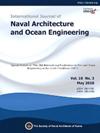IMO C型LCO2储罐基于规则设计蒸汽压力要求的比较研究:优化压力条件指南
IF 3.9
3区 工程技术
Q2 ENGINEERING, MARINE
International Journal of Naval Architecture and Ocean Engineering
Pub Date : 2025-01-01
DOI:10.1016/j.ijnaoe.2025.100668
引用次数: 0
摘要
安全高效的液化二氧化碳(LCO2)储罐设计对于碳捕获、利用和储存(CCUS)至关重要,特别是在海上运输中。IMO C型压力容器广泛使用,其最小设计蒸汽压力由基于规则的标准确定。这些规则基于断裂力学原理,防止裂纹扩展引起的泄漏。然而,监管压力和操作压力之间的差异增加了设计的复杂性和迭代修改。本研究提出了一个热力学框架来评估基于规则的蒸汽压力和实际蒸汽压力之间的差距,并确定了压力控制和绝缘设计中与体积相关的含义。对1000-5000立方米储罐的模拟表明,小型储罐(1000-2000立方米)可能超过监管压力限制,需要加强绝缘或压力控制。相比之下,大型储罐(3000-5000立方米)受保守的基于规则的限制,这表明操作调整的潜力。研究结果为平衡效率和法规遵从性提供了早期设计指导,支持安全、经济的海上LCO2运输系统开发。本文章由计算机程序翻译,如有差异,请以英文原文为准。
Comparative study of vapor pressure requirements for rule-based design of IMO Type C tanks for LCO2: Guidelines for optimizing pressure conditions
The safe and efficient design of liquefied carbon dioxide (LCO2) storage tanks is essential for carbon capture, utilization, and storage (CCUS), particularly in maritime transport. IMO Type C pressure vessels are widely used, with minimum design vapor pressure determined by rule-based criteria. These regulations, based on fracture mechanics principles, prevent crack propagation-induced leaks. However, discrepancies between regulatory and operational pressures increase design complexity and iterative modifications. This study presents a thermodynamic framework to assess the gap between rule-based and actual vapor pressures and identifies volume-dependent implications for pressure control and insulation design. Simulations for 1000–5000 m3 tanks show that small tanks (1000–2000 m3) may exceed regulatory pressure limits, requiring enhanced insulation or pressure control. In contrast, large tanks (3000–5000 m3) are governed by conservative rule-based limits, suggesting potential for operational adjustments. The results offer an early-stage design guide balancing efficiency and regulatory compliance, supporting safe, economical marine LCO2 transport system development.
求助全文
通过发布文献求助,成功后即可免费获取论文全文。
去求助
来源期刊

International Journal of Naval Architecture and Ocean Engineering
ENGINEERING, MARINE-
CiteScore
4.90
自引率
4.50%
发文量
62
审稿时长
12 months
期刊介绍:
International Journal of Naval Architecture and Ocean Engineering provides a forum for engineers and scientists from a wide range of disciplines to present and discuss various phenomena in the utilization and preservation of ocean environment. Without being limited by the traditional categorization, it is encouraged to present advanced technology development and scientific research, as long as they are aimed for more and better human engagement with ocean environment. Topics include, but not limited to: marine hydrodynamics; structural mechanics; marine propulsion system; design methodology & practice; production technology; system dynamics & control; marine equipment technology; materials science; underwater acoustics; ocean remote sensing; and information technology related to ship and marine systems; ocean energy systems; marine environmental engineering; maritime safety engineering; polar & arctic engineering; coastal & port engineering; subsea engineering; and specialized watercraft engineering.
 求助内容:
求助内容: 应助结果提醒方式:
应助结果提醒方式:


